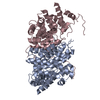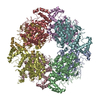[English] 日本語
 Yorodumi
Yorodumi- PDB-8qzp: Structure of the non-mitochondrial citrate synthase from Ananas c... -
+ Open data
Open data
- Basic information
Basic information
| Entry | Database: PDB / ID: 8qzp | |||||||||||||||||||||
|---|---|---|---|---|---|---|---|---|---|---|---|---|---|---|---|---|---|---|---|---|---|---|
| Title | Structure of the non-mitochondrial citrate synthase from Ananas comosus | |||||||||||||||||||||
 Components Components | Citrate synthase | |||||||||||||||||||||
 Keywords Keywords | TRANSFERASE / Complex | |||||||||||||||||||||
| Function / homology |  Function and homology information Function and homology informationacyltransferase activity, acyl groups converted into alkyl on transfer / fatty acid beta-oxidation / tricarboxylic acid cycle / peroxisome / carbohydrate metabolic process / mitochondrial matrix Similarity search - Function | |||||||||||||||||||||
| Biological species |  | |||||||||||||||||||||
| Method | ELECTRON MICROSCOPY / single particle reconstruction / cryo EM / Resolution: 4.15 Å | |||||||||||||||||||||
 Authors Authors | Lo, Y.K. / Bohn, S. / Sendker, F.L. / Schuller, J.M. / Hochberg, G. | |||||||||||||||||||||
| Funding support |  Germany, European Union, 3items Germany, European Union, 3items
| |||||||||||||||||||||
 Citation Citation |  Journal: bioRxiv / Year: 2024 Journal: bioRxiv / Year: 2024Title: Frequent transitions in self-assembly across the evolution of a central metabolic enzyme. Authors: Franziska L Sendker / Tabea Schlotthauer / Christopher-Nils Mais / Yat Kei Lo / Mathias Girbig / Stefan Bohn / Thomas Heimerl / Daniel Schindler / Arielle Weinstein / Brain P Metzger / ...Authors: Franziska L Sendker / Tabea Schlotthauer / Christopher-Nils Mais / Yat Kei Lo / Mathias Girbig / Stefan Bohn / Thomas Heimerl / Daniel Schindler / Arielle Weinstein / Brain P Metzger / Joseph W Thornton / Arvind Pillai / Gert Bange / Jan M Schuller / Georg K A Hochberg /   Abstract: Many enzymes assemble into homomeric protein complexes comprising multiple copies of one protein. Because structural form is usually assumed to follow function in biochemistry, these assemblies are ...Many enzymes assemble into homomeric protein complexes comprising multiple copies of one protein. Because structural form is usually assumed to follow function in biochemistry, these assemblies are thought to evolve because they provide some functional advantage. In many cases, however, no specific advantage is known and, in some cases, quaternary structure varies among orthologs. This has led to the proposition that self-assembly may instead vary neutrally within protein families. The extent of such variation has been difficult to ascertain because quaternary structure has until recently been difficult to measure on large scales. Here, we employ mass photometry, phylogenetics, and structural biology to interrogate the evolution of homo-oligomeric assembly across the entire phylogeny of prokaryotic citrate synthases - an enzyme with a highly conserved function. We discover a menagerie of different assembly types that come and go over the course of evolution, including cases of parallel evolution and reversions from complex to simple assemblies. Functional experiments in vitro and in vivo indicate that evolutionary transitions between different assemblies do not strongly influence enzyme catalysis. Our work suggests that enzymes can wander relatively freely through a large space of possible assemblies and demonstrates the power of characterizing structure-function relationships across entire phylogenies. | |||||||||||||||||||||
| History |
|
- Structure visualization
Structure visualization
| Structure viewer | Molecule:  Molmil Molmil Jmol/JSmol Jmol/JSmol |
|---|
- Downloads & links
Downloads & links
- Download
Download
| PDBx/mmCIF format |  8qzp.cif.gz 8qzp.cif.gz | 555.8 KB | Display |  PDBx/mmCIF format PDBx/mmCIF format |
|---|---|---|---|---|
| PDB format |  pdb8qzp.ent.gz pdb8qzp.ent.gz | 460.6 KB | Display |  PDB format PDB format |
| PDBx/mmJSON format |  8qzp.json.gz 8qzp.json.gz | Tree view |  PDBx/mmJSON format PDBx/mmJSON format | |
| Others |  Other downloads Other downloads |
-Validation report
| Summary document |  8qzp_validation.pdf.gz 8qzp_validation.pdf.gz | 1.2 MB | Display |  wwPDB validaton report wwPDB validaton report |
|---|---|---|---|---|
| Full document |  8qzp_full_validation.pdf.gz 8qzp_full_validation.pdf.gz | 1.3 MB | Display | |
| Data in XML |  8qzp_validation.xml.gz 8qzp_validation.xml.gz | 100.3 KB | Display | |
| Data in CIF |  8qzp_validation.cif.gz 8qzp_validation.cif.gz | 148.5 KB | Display | |
| Arichive directory |  https://data.pdbj.org/pub/pdb/validation_reports/qz/8qzp https://data.pdbj.org/pub/pdb/validation_reports/qz/8qzp ftp://data.pdbj.org/pub/pdb/validation_reports/qz/8qzp ftp://data.pdbj.org/pub/pdb/validation_reports/qz/8qzp | HTTPS FTP |
-Related structure data
| Related structure data |  18779MC  8qwbC M: map data used to model this data C: citing same article ( |
|---|---|
| Similar structure data | Similarity search - Function & homology  F&H Search F&H Search |
- Links
Links
- Assembly
Assembly
| Deposited unit | 
|
|---|---|
| 1 |
|
- Components
Components
| #1: Protein | Mass: 57611.801 Da / Num. of mol.: 8 Source method: isolated from a genetically manipulated source Source: (gene. exp.)   Has protein modification | N | |
|---|
-Experimental details
-Experiment
| Experiment | Method: ELECTRON MICROSCOPY |
|---|---|
| EM experiment | Aggregation state: PARTICLE / 3D reconstruction method: single particle reconstruction |
- Sample preparation
Sample preparation
| Component | Name: Octameric complex of non-mitochondrial/glyoxysomal citrate synthase from Ananas comosus Type: COMPLEX / Entity ID: all / Source: RECOMBINANT |
|---|---|
| Molecular weight | Experimental value: NO |
| Source (natural) | Organism:  |
| Source (recombinant) | Organism:  |
| Buffer solution | pH: 7.3 |
| Specimen | Embedding applied: NO / Shadowing applied: NO / Staining applied: NO / Vitrification applied: YES |
| Vitrification | Cryogen name: ETHANE-PROPANE / Humidity: 100 % / Chamber temperature: 277 K |
- Electron microscopy imaging
Electron microscopy imaging
| Experimental equipment |  Model: Titan Krios / Image courtesy: FEI Company |
|---|---|
| Microscopy | Model: FEI TITAN KRIOS |
| Electron gun | Electron source:  FIELD EMISSION GUN / Accelerating voltage: 300 kV / Illumination mode: FLOOD BEAM FIELD EMISSION GUN / Accelerating voltage: 300 kV / Illumination mode: FLOOD BEAM |
| Electron lens | Mode: BRIGHT FIELD / Nominal magnification: 29000 X / Nominal defocus max: 3000 nm / Nominal defocus min: 500 nm |
| Image recording | Electron dose: 55 e/Å2 / Film or detector model: GATAN K3 (6k x 4k) |
- Processing
Processing
| EM software | Name: PHENIX / Category: model refinement | ||||||||||||||||||||||||
|---|---|---|---|---|---|---|---|---|---|---|---|---|---|---|---|---|---|---|---|---|---|---|---|---|---|
| CTF correction | Type: PHASE FLIPPING AND AMPLITUDE CORRECTION | ||||||||||||||||||||||||
| 3D reconstruction | Resolution: 4.15 Å / Resolution method: FSC 0.143 CUT-OFF / Num. of particles: 108304 / Symmetry type: POINT | ||||||||||||||||||||||||
| Refine LS restraints |
|
 Movie
Movie Controller
Controller


 PDBj
PDBj

